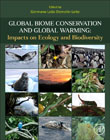
Global Biome Conservation and Global Warming: Impacts on Ecology and Biodiversity
Demolin-Leite, Germano Leão
Global Biome Conservation and Global Warming: Impacts on Ecology and Biodiversity assesses the status of all global aquatic and terrestrial biomes, including impacts on species biodiversity and biome climates. It summarizes operational and potential monitoring tools to conserve or to recover biomes on a global scale, using proven scientific case studies. This is a collaborative project with experts from around the world who specialize in types of biomes or regional studies to create a global picture of climate change and human impacts. This links the main challenges and threats causing major biome decline to their living organisms, such as arthropods, birds, mammals, and invertebrates. Global Biome Conservation and Global Warming: Impacts on Ecology and Biodiversity is a vital resource for conservationists and scientists studying biodiversity, ecology, and zoology amidst global climate change. Students, academics, and policy makers can also benefit from the practical case study information included in this book Provides proven case studies for conservation and recovery efforts per habitat or biomeCovers freshwater and marine biomes, including all major oceansAlso covers terrestrial biomes from all continents, including deserts, tundras, insular biomes, and moreExplains the use of ecological indicators, e-DNA, and remote sensing to analyze biome conditions INDICE: Section I: Freshwater 1. Amazon River 2. Danube River 3. Mississippi River 4. Murray River 5. Nile River 6. Yangtze River 7. Lake Baikal 8. Lake Great 9. Lake Ladoga 10. Lake Superior 11. Lake Titicaca 12. Lake Victoria 13. Arafura Wetland 14. Danube Delta Wetland 15. Kabartal Wetland 16. Okavango Delta Wetland 17. Okefenokee Wetland 18. Pantanal Wetland Section II: Marine 19. Estuaries 20. Coral Reefs 21. Coastal Areas 22. Deep Seas 23. Atlantic Ocean 24. Indian Ocean 25. Pacific Ocean 26. Arctic and Antarctic Oceans Section III: Desert 27. Antarctica and the Arctic 28. Arabian and Syrian Deserts 29. Atacama and Patagonia 30. Gobi Desert 31. Great Basin Desert 32. Great Victoria Desert 33. Indian Thar 34. Kalahari and Sahara Section IV: Insular Biomes 35. Australia 36. California 37. Chile 38. Mediterranean Basin 39. South Africa Section V: Prairies and Steppes 40. Asia 41. European 42. American Section VI: Shrublands 43. Dwarf Shrublands 44. Interior Shrublands 45. Mediterranean Shrublands 46. Xeric Shrublands Section VII: Savannas 47. Africa 48. Asia 49. Australia 50. North and South American Section VIII: Taigas 51. Asia 52. North America 53. Northern Europe Section IX: Temperate Forests 54. Asia 55. Australia 56. Europe 57. North and South America Section X: Tropical Forests 58. Africa 59. Amazon 60. Asia 61. Atlantic Forests - Restinga and Caatinga 62. Australia 63. Central America Section XI: Tundras 64. Asia 65. Europe 66. North America Section XII: Innovative Techniques in Conservation and Remote Sensing 67. Biome Functioning and Bioindicators 68. Ecological Informatics 69. E-DNA 70. Long-Term Biome Biomonitoring 71. Machine Learning 72. Remote Sensing 73. Statistical Analysis Section XIII: Global Warming Perspectives for 50 Years 74. Freshwater and Marine 75. Deserts 76. Insular Biomes 77. Mediterranean and Shrublands 78. Prairies and Steppes 79. Savannas 80. Temperate and Tropical Forests 81. Glaciers and Tundras 82. Subterranean
- ISBN: 978-0-443-15726-4
- Editorial: Academic Press
- Encuadernacion: Cartoné
- Páginas: 800
- Fecha Publicación: 01/01/2025
- Nº Volúmenes: 1
- Idioma: Inglés
- Inicio /
- /
